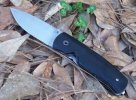The minimum chromium content required for a steel to be classified as stainless tends to vary a bit depending on who you ask. This is reasonable considering that the property of resisting corrosion is a sliding scale. It is not of case of either it is or it isn't. Stain resistant properties begin showing at about 10% chromium content. If all other element concentrations are held constant, then the higher the chromium content, the more corrosion resistant the alloy is.
I use Key to metals as a reference for such matters. They are a database for metallurgists. They also have reasonably definitive articles that you can access and read without being a member.
http://www.keytometals.com/Articles/Art62.htm
Per the AISI specification for D2, the alloy must contain between 11 and 13% Chromium.
http://www.efunda.com/materials/all...ol.cfm?ID=AISI_D2&prop=all&Page_Title=AISI+D2
That makes D2 "stainless steel", even if it is at the low end of the chromium content range, making it not as corrosion resistant as other "stainless alloys".


